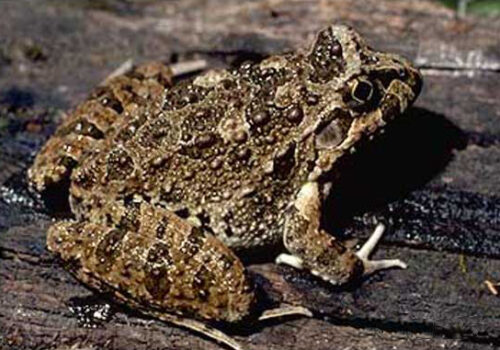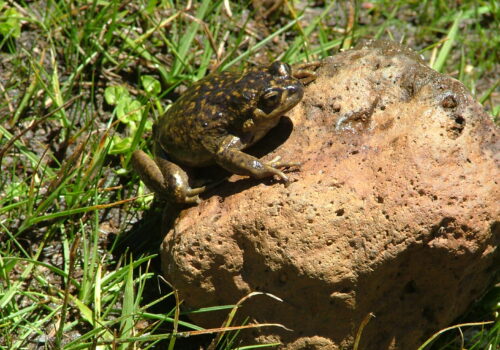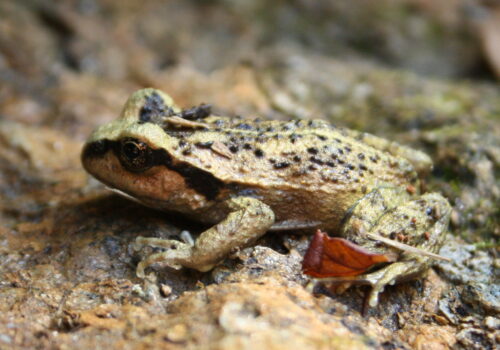- Into the Secret World of Alsodes montanus: The Mountain Frog of the Andes
- Taxonomy and Classification of Alsodes montanus
- Natural Habitat: Hidden High-Altitude Havens
- Physical Characteristics: Master of Disguise and Survival
- Behavior and Life Cycle: An Intimate Dance of Survival
- The Ecological Role of Alsodes montanus
- Threats and Conservation Status: A Fragile Existence
- Cultural and Scientific Significance: Understanding Hidden Lives
- Conclusion: Guardians of the High Andes
Into the Secret World of Alsodes montanus: The Mountain Frog of the Andes#
On an evening stroll through a mist-shrouded forest deep within the Andes, the air grows heavy with moisture and resonates with a delicate chorus of amphibian voices. In this rugged landscape, beneath rocks draped in moss and along glistening streams, dwells a creature seldom seen by human eyes—the elusive Alsodes montanus. Also known simply as the Mountain Spiny-chest Frog, this charming amphibian thrives where few others can, earning its rightful place as one of South America’s remarkable yet little-understood frog species.
Alsodes montanus, a humble but notable representative of the diverse Alsodidae family, embodies the haunting beauty and biodiversity richness of its high-altitude forest home. Although often overlooked, this shy amphibian holds profound importance to researchers, nature enthusiasts, and conservation advocates. While frogs are usually synonymous with wetlands and rainforests, the mountain frog’s tale reveals nature’s wondrous adaptability and resilience in harsh mountain habitats. Let us journey together into the world of Alsodes montanus—a life framed by mist, stone, and crystal-clear streams.
Taxonomy and Classification of Alsodes montanus#
The noble Alsodes montanus belongs to the family Alsodidae, a specialized lineage of frogs primarily endemic to temperate forests and mountain brooks in South America. Within this family, members of the genus Alsodes are known specifically for their adaptability in challenging environments characterized by rapid watercourses, rocky terrain, and cool temperatures typical at high altitudes.
The scientific name, “Alsodes montanus,” epitomizes its ecological niche—”montanus” aptly means “of the mountains.” Originally described in scientific literature by the noted herpetologist Philippi in 1902, Alsodes montanus has drawn interest due to its isolated, hard-to-access habitats, making research challenging yet deeply rewarding. It is closely related to other Alsodes species, themselves masterfully adapted to the varied ecosystems of southern Chile and Argentina.
Natural Habitat: Hidden High-Altitude Havens#
The existence of Alsodes montanus is tightly intertwined with its unique and often fragile environment. Native predominantly to southern Chile and adjacent regions of Argentina, this frog can primarily be found amid cool temperate forests, lush valleys, and steep mountain streams situated anywhere from 500 to well over 2,000 meters above sea level.
A Habitat Shaped by Elevation and Moisture#
Unlike its tropical counterparts sun-basking on broad leaves, Alsodes montanus prefers secluded microhabitats—slow-moving streams or moist terrains sheltered beneath and around large, moss-covered rocks and fallen logs. The chilly mountain air, consistent moisture, and abundant hiding places create an ideal refuge for the species, providing vital protection from predators and temperature extremes.
Each boulder-strewn creek or damp forest hollow harbors microclimatic conditions critical to the frog’s survival and reproduction. Thus, any alteration to the ecosystem—natural or human-induced—can have significant repercussions for Alsodes montanus, highlighting its sensitivity to environmental changes and making it an important indicator species for ecological health.
Physical Characteristics: Master of Disguise and Survival#
In appearance, Alsodes montanus is modest yet fascinating. Typically reaching between four and six centimeters in length, this small amphibian features sturdy limbs and rough-textured skin perfectly suited for life among stones and cold waters. Its coloration, predominantly shades of brown, gray, and olive, creates a cloak of invisibility against the rocky forest background, exemplifying the art of nature’s camouflage.
Adaptations for a Mountain Lifestyle#
The distinctive irregular warts and raised tubercles scattered upon its body offer not only added camouflage but enhanced sensory perception, detecting slight vibrations and changes in its environment. Moreover, their broad, strong feet equipped with tiny webbing serve as anchors amidst fast-moving mountain streams and aids gripping onto slippery surfaces.
Its most distinctive characteristic, giving it the nickname “Spiny-chest,” is the male’s roughened patches of thorny skin on their chest, used to hold onto females securely during mating—a key adaptation for breeding in the turbulent waters of springtime mountain streams.
Behavior and Life Cycle: An Intimate Dance of Survival#
Beneath their shy exterior lies fascinatingly complex behaviors evolved meticulously over millennia. Alsodes montanus is primarily nocturnal, emerging at dusk from sheltered hideouts to hunt various insects, spiders, and other invertebrates inhabiting its damp territory. During daylight hours, these reserved creatures remain virtually invisible, camouflaged and sheltered amid leaf litter and rocks.
The Elusive Courtship#
Remarkably synchronized to seasonal climatic rhythms, Alsodes montanus initiates mating activities primarily during late winter through early spring, dictated precisely by temperature shifts, arrival of spring rains, and snowmelt runoff. Male frogs produce delicate, low-pitched mating calls often lost to human ears amid rushing stream waters or gently rustling leaves. Females, keenly attuned, embark on sometimes treacherous journeys toward potential mates hidden deep among mossy stream beds.
Upon locating each other, the pair engages in a strong embrace called amplexus—males securely holding females with their specialized spiny chests—to facilitate fertilization of eggs externally. The female deposits modest clusters of gelatinous eggs attached securely onto underwater vegetation or sheltered rock crevices exposed to gentle currents, ensuring ample oxygen and a safer environment from aquatic predators or disturbance.
From Tadpole to Mountain Guardian#
Eggs hatch within weeks, releasing small, hardy tadpoles equipped to confront the ever-challenging mountain water ecosystem. These larvae, employing hidden crevices and rocks for shelter, scrape algae or detritus from submerged surfaces with specialized mouthparts until undergoing full metamorphosis into juvenile frogs. It is a rapid yet perilous growth period—an ordeal of survival amid currents, temperature fluctuations, and numerous lurking predators.
The Ecological Role of Alsodes montanus#
No species exists independently; like threads in a tapestry, Alsodes montanus occupies a vital ecological niche within mountain stream ecosystems. Its role as predator helps control insects and other small invertebrates, maintaining crucial balance within its ecosystem. Concurrently, it stands vulnerable—a food source for diverse avian predators, snakes, and mammals. Their tadpoles contribute ecosystem services by participating in nutrient cycling, enhancing water quality, and promoting an overall healthier aquatic environment.
An Indicator of Environmental Health#
The sensitive ecology and high vulnerability to environmental deterioration render Alsodes montanus profoundly valuable as biological indicators. Rapid decline or disappearance of mountain frogs serves as early distress signals for environmental deterioration that often go unnoticed until it’s detrimental for other life forms, including humans.
Threats and Conservation Status: A Fragile Existence#
As human populations expand, unfortunately, Alsodes montanus—like many amphibians worldwide—faces numerous existential threats. Currently listed by the International Union for Conservation of Nature (IUCN) as Data Deficient due to lack of comprehensive population studies, its secretive nature paradoxically renders it vulnerable because conservation efforts are limited by incomplete ecological baseline data.
The Impact of Habitat Degradation and Climate Change#
Habitat destruction via logging, water diversion, and agriculture profoundly is altering the fragile balance that Alsodes montanus relies upon. Moreover, climate shifts affecting rainfall patterns, snowmelt timing, and increasing temperatures may push this species beyond its current adaptive capacity, threatening localized extinction events across its natural range.
Cultural and Scientific Significance: Understanding Hidden Lives#
In indigenous cultures inhabiting the regions where Alsodes montanus dwells, amphibians symbolize fertility, renewal, and ecological health. For scientists, Alsodes montanus is deeply intriguing for studies into amphibian adaptation to cold environments and serves as a valuable species in climate change research. Its remarkable adaptations offer lessons about biological resilience, evolutionary biology, and drive continued efforts to unravel the mysteries surrounding its fascinating existence.
Conclusion: Guardians of the High Andes#
Our journey into the mesmerising yet hidden world of Alsodes montanus underscores the intricate web connecting even the smallest amphibians with expansive ecosystems. Their presence becomes an enduring symbol of wild natural landscapes, reminding us of the delicate interconnectedness of all species. Supporting research, conservation advocacy, and habitat protection, we safeguard not only the fortunes of Alsodes montanus but the environmental health of the breathtaking Andean ecosystems that shelter them.
By telling their quiet story, we illuminate the critical importance of biodiversity conservation. Taking action to preserve these overlooked amphibians is, in essence, protecting the very health of our shared natural world.










